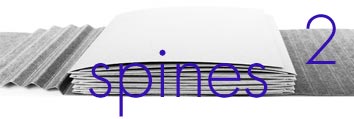
SPINES 2
Working advice: The measurements given in this description are generic and you should make your own. Click here to see the images.
TWOSTARS
I have a friend who is a passionate pop-up maker and one day I decided to try some elementary tricks myself like the first flight of this shy little bird (see image 1).
Right from the beginning it seemed clear that I had to make a particular book structure to hide part of the movements.
I had seen a double spine structure where the pages of the two resulting books overlapped one another and I decided to do something similar, adapting it to my needs. I kept the idea of the two spines but converted them into concertinas to create mobility and inner space.
How to make it
The two concertina books are made of a series of medium weight pieces of paper folded in two; in order to avoid having problems with the folding make sure that the grain direction of the paper is correct (i.e. head to tail).
The double pages facing one another are linked together by gluing the fore-edges into each alternate fold (see image 2).
For quick and clean fixing of the edges you can also use double-sided acid free adhesive tape 6mm wide or more according to the size of the book (I have not yet had the opportunity to check the durability of this method).
There is no length limitation for this kind of double page concertina. You need to remember that each book should have a flyleaf at the beginning and at the end, which means that you have to make the concertinas with an uneven number of folded pages.
The cover
Before making the cover put the two concertina books in their final position: that is, each page overlapping one in the book opposite, with a spine on each side.
For the cover you will need a long piece of strong paper a bit longer than the book and three times its width plus 200mm or more for the spine concertinas.
With a pencil make a very light mark in the middle of the paper's width and place the centre of the book-block over that mark.
With a bone folder score a vertical line, say, 6mm away from each side of the book-block. Then score a number of lines on both sides keeping that same distance between them (see image 3). The distance between the lines should be more or less the same as the distance between the spine folds when the two book-blocks are inserted into one another.
You will need two lines for each spine fold of the books plus one, for example: for two books with five spine folds you will need eleven lines each side of the book-block.
Fold the concertinas to make the two spines.
The sewing
Pierce three holes at each spine fold and at each corresponding fold at the cover and sew the pages to the cover with a pamphlet sewing stitch (each fold being sewn separately). You can find the pamphlet sewing in section "Gathering Gatherings" of this website.
When the sewing of the two spines is finished overlap, again alternately, the pages of the two books and cut the covers to size (see image 4).
The two covers are laid one on top of the other and two complementary cuts keep them closed. They can also be hooked at the back when the book is in its opened position (see image 5). When the book is wide open the two spines become TwoStars (see images 5 and 6).
How to use this structure
The TwoStars structure may have different uses: for poetry with two different groups of texts overlapping one another, for a bilingual text with each language opposite its translation, for photos or drawings alternating with text...
Every time you need to emphasise opposition or superimposition this structure will be handy.